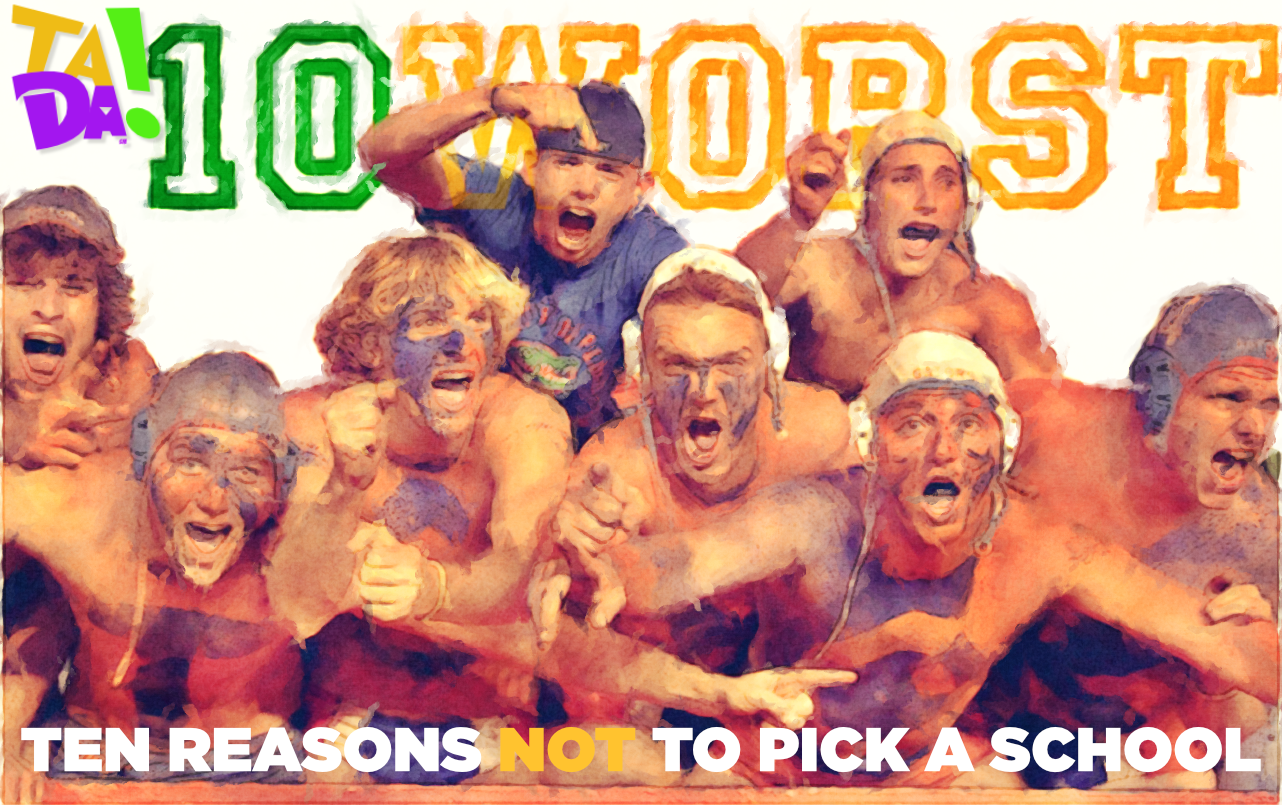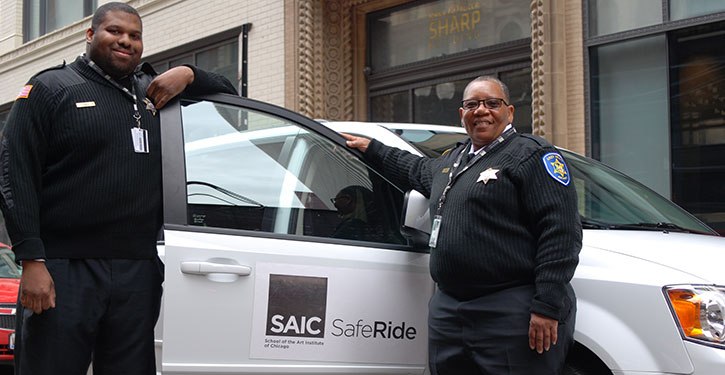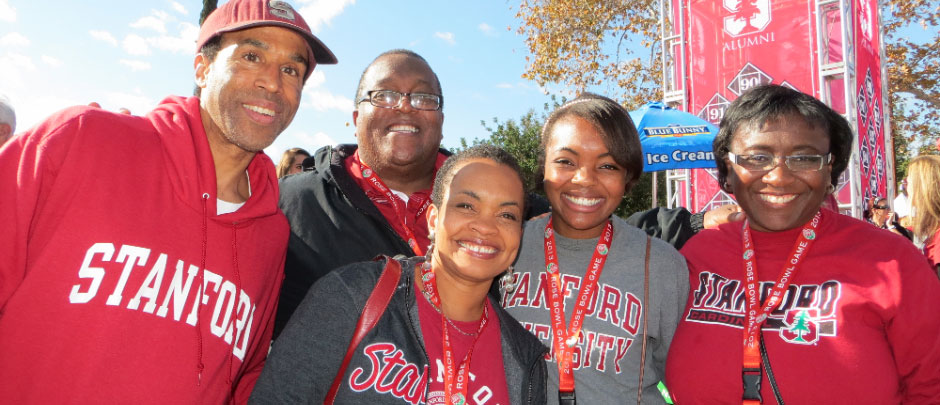
There are a lot of good reasons to choose a school, but these ten can be why you become one of the millions of college students who transfer, or, worse still, settle for less. You will make three personal, major decisions in your life: Pick a college path, who you marry/cohabitate with, and what you will do to make a living.
Don’t screw this up! Avoid these TaDa! Ten worst reasons to pick a college:

My friends have gone there and liked it.
What’s better than a recommendation from a friend?
Research.
Even if your friend is in the same major/life track, the right choice for them may not be the right choice for you.

Every school has good majors/departments, and bad. The Philosophy Department might rock, while their Biology Department is overcrowded.
Do your research of the professors, and the curriculum. The right school for you is where the faculty gets you excited about a pathway that leads to life where you can be passionate about what you do.

I’m an [INSERT YOUR TEAM HERE] fan…
For years, possibly your whole life, you’ve grown up watching a college team.
You really want to be part of that experience of painting your face and screaming at the top of your lungs.
With a few exceptions, like Duke, or University of Miami, most of the big NCAA Division I schools are stuffed to the eyeballs with students.

Imagine, if NCAA Football was run like the colleges that they represent! How could you play a game with 1,000 or more players on the field? If you think that would be whack for a game, why is it any less mad for your major? The football programs at most big schools are far more selective than their academic majors.
Which is better? 1,000 students for 8-12 in faculty, or 90 students with 6 in faculty?
Your team, the major at the school you attend, needs to be lean and mean.
There are many great Div II and Div III schools with great sports programs. Sit closer to the action and cheer there.
OR, buy a jersey from one of the those super-sized schools and catch their games on TV.
Fandom is not a reason to attend a college or university.

It’s “Free” or “Affordable.”
Cost is a HUGE anxiety in planning for higher education. No question about it.
So when you get the opportunity to have your state’s LOTTO foot most or all of the bill, that’s a great deal, right?!
Maybe.
FREE doesn’t always mean GOOD, or even right for your needs.
But… But… Why would you pay when you don’t have to?!

Cash v. Outcomes.
Look at the big picture. Where are you going, not just to college, but in six years? Eight? If you’re thinking about getting a Masters, MBA, law, or medical degree, you’re going to need help getting there. How do you do that?
MAFIA. Professors, and alumni who have your back. You need support. You need letters of recommendation. You need capstones, and the opportunity to work with great people who are high earners.
A public college like New College of Florida, with 1300-1500 students, has capstones, and good Mafia. So, if Bright Futures, Florida’s scholarship plan, makes it free, at that school, that is a good thing.
A public college like University of Central Florida, though, with 56,000 students, graduates roughly 14,000 students into the world annually. You might get a professor to write you a letter of recommendation for grad school, or get you an introduction into a company with a good paying job, straight out of undergrad?
Are they going to do it for hundreds, or thousands of other people in your major?
Probably not.
You have to balance OUTCOMES against Price Tag. You also have to consider location. Certain areas, where the top business in a field is headquartered, put you in range of opportunity.
Cash v. Location, Location, Location.
A school in New Mexico with “free” in-state tuition, that has a weak department in Marine Science, may not be as good as a Coastal Carolina University, or University of Hawaii, Manoa, which are leaders in the field.
Still, I hear your thrifty side say, would it be okay to go to the lower-quality program, and save $10-$15K?
Median starting income for a UCF computer sciences grad? $58,450. For a Mudd College grad? $97,900.
$39,450 more a year. Maybe that’s worth an investment beyond the “free?”
Remember: Just like with a car, the “sticker” prices aren’t the real prices unless your family makes a combined income of $200K or more.
For everyone else, we fill out the FAFSA and the CSS profile. They will help you get an Estimated Cost of Attendance. Your ECA may come out very high, far higher than your actual tuition will be.
ECAs are built by financial aid calculators that don’t take into account how desirable you are, or how many cohorts you fill for the school’s admissions office.
Be a good educational shopper.
No school gives you their final offer when they send the first financial aid package out with acceptances. Haggle, and get a deal that you want. Many often come out much lower than the Estimated Cost of Attendance (ECA).

Scholarships also offset “gap” money, between what a college will pay and what you can afford. See the Scholarships article for more.
Bottom Line: Most students can get one or more schools to the point where if you work part-time, you can earn at least $10,000 a year to cover enough of your funding gap. Families have to sit down and figure out how much the student, and how much the family, can afford to contribute. That number is your acceptable “gap.”
Compare earning power from each school. Great faculty, good size, and better earning power are all compelling reasons to pass on the short-term gain.
Fear of Going Far/Away from Family

It’s very normal. People with strong family ties, where the comfort value of going to a school farther away is limited to where you have relatives. Many people are apprehensive about wandering far from home.
Some truths about college that you really need to know before you pull that trigger on your decision-making process.
Every year, students panic. “What if something HAPPENS TO ME?” They start looking at schools that are often not as ideal for them. They trade off a real fear of the unknown, for a future that may be much better in a school farther away, with professors and/or a location ideally suited to their pursuits and dreams.
You want to study film? Sure you can do it in places like Williamsburg or Tallahassee. How many movies are shot there? How many jobs in the industry nearby? What MAFIA are you going to have that is going to get you working? Atlanta, Los Angeles, New York, London? Farther away, but they may be much better calls.
Life in the College “Bubble.”
Once you’re in. You’re in. You become part of “la famiglia” of that school. There are a TON of people that have your back. Not only new friends, but Residence Advisors, colleagues in your major, professors, campus safety officers.

Most students venture outside of their colleges a bit, but not terribly far. Even if you go to school nearby, that’s pretty much the case. Few people go home on weekends, or have their parents up at campus twice a month hanging out.
Your parents drop you off. They pick you up. At least through the first couple of years. They come to campus MAYBE for a parents weekend, or Homecoming, or some special annual event.
It can seem like having an aunt, uncle, third cousin, friend of the family nearby is that “lifeline,” that makes a school viable.
It doesn’t.
If you have real problems, all of the support systems at school kick in. Even at the biggest schools, student health, welfare, and safety are Job One.
When you visit schools, or talk to admissions officers, ASK about the campus community, public safety, etc.
You CAN take a break from where you are, if the opportunity to study someplace further away means that you get a better education, earn more money, come back to your community with more knowledge and power, and create a better life for yourself.
See your family on the holidays, at breaks, and over the parts of the summer where you’re not doing research or work someplace that will help you get along in the world.
They love you. Your school will love you. It takes a village. It’s OKAY.

“My [parent] won’t let me go that far away”
Then there’s the flip-side of that challenge in picking colleges.
When you turn thirteen, moms have this nightmare. You’re headed off to college across the country. When you get to the Mississippi, dragons shoot up out of the river, eat the airplane, and you’re never seen again.

That is such a pervasive fear, that schools have to work harder to fill their geographical diversity cohort. get a better ‘bounce’ in geographical diversity, which can also help with scholarship and/or financial aid money, if you look farther away from home.
You, and your evil twin from across the country, have the exact same everything: Scores, grades, essays, hobbies, interests. You come from Florida. They’re in California. Your “Floridaness” is a cohort that can land you in a slot in Cali. For some schools, to attract geographical diversity means providing merit or other incentive bonuses to get you.
The Travel/Distance Myth
There is also a time/cost/distance myth about school travel, that places like Los Angeles are “too far away.” Students in Florida can take a 5-1/4 hour non-stop flight to Los Angeles where the airfare, being a large business and personal travel corridor, are stable and pretty cheap.
Fly from Florida to cities on the Eastern Seaboard, and you will be connecting through a hub 95% of the time. That’s 3-6 hours for most flights, including layovers. Not much different.
Particularly at many smaller East Coast airports, they know when schools start and stop. Airfares, even in large metros, like Boston, can soar up 300-600% on crunch days for college students because they know parents will pay anything to get their kids home for the holiday.
Don’t gauge your travel in geographical distance, but in hours taken to get to your destination.
Travel Secret
Grab airline miles credit cards, and use them for ALL of your purchases: Gas, market, more. As long as you pay them off to the statement balance in full, there isn’t any interest charged. You do, however, pick up miles that will make it cheaper for your student and you to travel at peak periods.

I love [INSERT TOWN HERE]!
You have to live someplace for four to six years. Quality of life is a big factor in where you go to school.
Students can get excited about obvious destinations like Boston, New York, Los Angeles, San Francisco, etc.

How about Pittsburgh, Pennsylvania? Cleveland, Ohio? Portland, Oregon? Terre Haute, Indiana? Oberlin, Ohio?
You’d be surprised that many schools have a similar, even better quality of life. More important, because students tend to stampede all of the colleges in the more obvious places, schools in the smaller towns have higher admissions rates than their “super city” counterparts.
Equally great schools have to work harder to offer you a package that will attract you to them.

My S.O. Wants to Go There with Me.
High school relationships can seem eternal now. On the numbers, we’ve got to tell you that they’re not.
Without being indelicate, most, sadly, fail.

College is a very different place. Both of you being out on your own. The exposure to all kinds of new people is part of the “Who am I?” component of college. Carryover relationships from high school are difficult, at best.
That’s especially true when, as is often the case, one of you is a class year or two ahead of the younger partner.
Even when you’re in the same class, it can be a problem. The change is a big one, and people start to grow in different directions.
If you decide that you must, don’t let the admissions committee know. If a student lets on that the reason that they want to attend a school is because their significant other is there, that is the kiss of death on an application.
Enjoy your year. Enjoy the summer. When it’s time to pack up to head to wherever life takes you next, be good friends, but try very hard to move on, and focus on your own life.

My Dad, Mom, Uncle, Cousin, etc. went there.
If you’re applying for a school, there is a BIG bump-up for being a “legacy,” the child of a member of the alumni.
Easy admission? Legacy used to be a guarantee. Less so in this age.
It’s not a done-deal. One affluent grandfather built a building at Harvard a few years before his grandson was to attend. The grandson didn’t get in! Not all schools pander to alumni relationships.

The harder question: Is the school still the same quality that it was when your relative attended?
Your parents, or grandparents, went to school in the pre-computer era, when dinosaurs roamed the Earth. Paper applications, and fewer applicants going to college, meant opportunity for all who applied.
The quality of the education that the institution can offer to undergrads has changed in the electronic application age. School funding, particularly at state schools, has been drying up since the Great Recession of 2008. The number of students admitted has soared, to meet “free” education programs like Blue and Gold, or Bright Futures.
It has been getting far worse during COVID-19, when families, even more financially stressed, have to make tough financial choices about higher ed.
If parents put more premium on the piece of paper being offered, for its symbolism in the workforce, than the education in the ideas that really matter in that workforce that it was supposed to represent, please, all, breathe, and consider the following.
If 5,000 undergrads barely paid for campus infrastructure, and graduate research, then, to a cash-strapped college, 18,000 to 87,000 is a gift.
Even the hustle of the application process is tainted by financial gain. Some colleges, like Columbia, work to stay in the US News top tens because they make more than a million dollars just from the application process alone!
If you went to a smaller, to medium, private undergrad, a Bates, or Reed,, Miami, or Duke, chances are that the educational experience has remained pretty much the same. Their costs have skyrocketed, but size has not changed enough to take them out of the way that they educate students.
For many schools, though, that is not the case. Top state colleges like UC Berkeley, University of Maryland, University of Florida, and the University of Texas, to name only a few, have had to double and triple their size.
Today, state governments refuse to build more capacity for higher education. They force their public colleges, and universities beyond their intended designs for 9,600-10,000 students, or 10-15,0000 students, to student body numbers 200-400% higher, where the student to faculty ratio in the entry-level classes balloons up to 500 to 1000 kids in one classroom,, how can a professor educate them as equally as a private university, where the students know their professors?
How would a student, in high school, do in a school with 50,000 high school students, in a place built for 10,000? Would you, or your parents, be happy with 1,000 kids in a classroom, in high school? How does that get better, when the learning counts even more, towards life, in college?
We advise students, wanting to belong to a family educational “tribe,” and parents, nostalgic for their college days, who are eager for their kids to wear the same college gear, have that “college experience” that they had, to check out the changes in their schools over the last 18-30 years since they were there.
If the school has changed a lot, write down a list of what made it right for your parent at the time. Find schools that do that same thing NOW.
You and your student can look through thousands of other colleges and universities and we’ll guarantee you find one with the size, location, and vibe that drew you to your alma mater.

[FAMOUS PERSON] Went To School There/Taught There
Schools love to sell their well-known alumni as a pitch to get you to attend their institution. Don’t go to a school because your favorite TV actor went there.
Astrophysicist Neil deGrasse Tyson went to Harvard, and taught for a time at the University of Maryland. Oberlin College has a book of its famous alumni, including the Charles brothers, who produced the TV show “Cheers,” better known to most parents. Documentarian Ken Burns attended Hampshire College.
A famous person in your career objective may have had different faculty. Whomever taught these people, more than two decades ago, may or may not still be there. Faculties at most college campuses experience turnover that changes them.

Cooper Union has changed over the years, and, in our opinion, not for the better. On the other hand, some schools’ departments are long-running powerhouses. USC or NYU Cinema, Johns Hopkins pre-med, M.I.T. engineering have both the resources and the clout to continue to attract the best in their fields.
Study the department’s faculty list in your area of major and read up on the professors teaching there. Are they interesting? Are they doing work in an area that you are passionate about? That is more important, since they’re the ones teaching you.

If I go [Here] I will be a lock to do [Career] or get into grad school
While the likelihood of success in certain fields does greatly improve based upon where you go to school, there are other factors that are important to not ignore.
The faculty (see above) list should be checked to see who is teaching there. Are they doing cutting edge work or merely hiding in academia?
It also has a lot to do with the kind of hard work you’re going to put into your education.
People think, if they got into film school, or a conservatory, or even into a good pre-med track, that all they have to do is ride the tide.
Having “Harvard” on your resume as an undergraduate is nice, but if you didn’t max your advantage while you are there, it won’t open nearly as many doors as you think.
Parents conflate nameplate with success. That’s more of a graduate school thing.
At the undergrad level, in Marine Biology, Boston University and Duke may be two of the best, but Eckerd and the University of Hawaii, Hilo, may, particularly for your interests, be far better.
Their faculty may set you up to work with top faculty in graduate school, because of the peer-to-peer connections of faculty at different schools, better than moving from Nameplate School A to Nameplate School B.Hard work with a professor that can mentor you to be a success beats a nameplate in the undergrad most of the time.
Smaller, often more unknown colleges, offer better pathways to the ‘nameplate’ schools. Check out our list of the Amazing Schools on the Road Less Traveled.


Pingback: Don’t Let the Supplementals Make You MENTAL – TaDa!Education
Pingback: Why Me? & Other College Search Myths – TaDa!Education